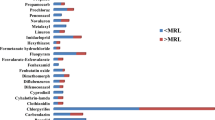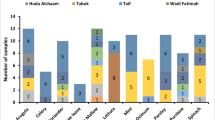Abstract
Pesticides are the potent agrochemicals used to successfully manage, repel, or stop pests and weeds in agricultural production. This study analyzed 222 pesticide active substances in 90 samples of seven different vegetables and fruits acquired from producers through liquid chromatography-mass spectrometry/mass spectrometry (LC–MS/MS) and gas chromatography-mass spectrometry/mass spectrometry (GC–MS/MS) technology. The validation parameters of each pesticide’s active substances were determined. The LOD, LOQ values, and recovery studies of the 222 active substances were 3.00, 10.00 ng/g, and between 76.07 and 108.08%, respectively. The correlation coefficients and measurement uncertainty were determined to be between 0.990–0.999 and 8.91–31.46%, respectively. There were active substances of chlorpyrifos, acetamiprid, azoxystrobin, difenoconazole, malathion, dieldrin, boscalid, triticonazole, tebuconazole, triadimenol, trifloxystrobin, pirimicarb, and dodine among the vegetable and fruit samples used in the study. There were no active substances in 55 (61%) samples. Among the 35 samples (39%), 31 samples (34%) contained only one active substance, whereas four (5%) contained two active substances. However, the amount of active substances in six (7%) samples was above the maximum residue levels (MRL) limits. Various processes used in the study revealed that peeling was the most effective pesticide residue removal strategy. The washing procedure also proved that it reduced some pesticide residues but failed to eliminate all pesticides. The peeling process successfully reduced a significant amount of the active substances from the products, however, residues remained. Washing the fruits with hot water was also effective in removing residues. As a result, analyses of the peeled sections yielded higher pesticide residue concentrations than those of the entire product.


Similar content being viewed by others
Data availability
The corresponding author will provide the data that support the study’s conclusions upon reasonable request.
References
Andrade, G. C., Monteiro, S. H., Francisco, J. G., Figueiredo, L. A., Rocha, A. A., & Tornisielo, V. L. (2015). Effects of types of washing and peeling in relation to pesticide residues in tomatoes. Journal of the Brazilian Chemical Society, 26(10), 1994–2002. https://doi.org/10.5935/0103-5053.20150179
Arias, N., Arazuri, S., & Jarén, C. (2013). Ability of NIRS technology to determine pesticides in liquid samples at maximum residue levels. Pest Management Science, 69(4), 471–477. https://doi.org/10.1002/ps.3392
Bempah, C. K., Agyekum, A. A., Akuamoa, F., Frimpong, S., & Buah-kwofie, A. (2016). Dietary exposure to chlorinated pesticide residues in fruits and vegetables from Ghanaian markets. Journal of Food Composition and Analysis, 46, 103–113. https://doi.org/10.1016/j.jfca.2015.12.001
Calvo, H., Redondo, D., Remón, S., Venturini, M. E., & Arias, E. (2019). Efficacy of electrolyzed water, chlorine dioxide and photocatalysis for disinfection and removal of pesticide residues from stone fruit. Postharvest Biology and Technology, 148, 22–31. https://doi.org/10.1016/j.postharvbio.2018.10.009
Cervera, M. I., Portolés, T., Pitarch, E., Beltrán, J., & Hernández, F. (2012). Application of gas chromatography time-of-flight mass spectrometry for target and non-target analysis of pesticide residues in fruits and vegetables. Journal of Chromatography A, 1244, 168–177. https://doi.org/10.1016/j.chroma.2012.04.063
Chavarri, M. J., Herrera, A., & Ariño, A. (2004). Pesticide residues in field-sprayed and processed fruits and vegetables. Journal of the Science of Food and Agriculture, 84(10), 1253–1259. https://doi.org/10.1002/jsfa.1791
Elmastas, A. (2018). Yaş Meyve Sebze Ürünlerinin Çeşitli Koşullarda Pestisit Kalıntılarının LC -MS/MS Ve GC- MS/MS ile Analizlerinin Kantitatif Tayini. Dicle University.
Elmastas, A., Umaz, A., Pirinc, V., & Aydin, F. (2022). Evaluation as time-dependent of pesticides applied in pre-harvest period of grown vegetables : Removal of pesticide residues in the vegetables. International Journal of Environmental Analytical Chemistry, 00(00), 1–28. https://doi.org/10.1080/03067319.2022.2085040
Ersoy, N., Tekinarslan, O., Ozgür, E. A., & Göktas, U. (2018). Determination of pesticide residues in apricot (Prunus armeniaca L.) grown at good agricultural practices (GAPs) by LC-MS/MS and GC-MS. Erwerbs-Obstbau, 60(4), 349–358. https://doi.org/10.1007/s10341-018-0383-9
European Commission. (2019). Guidance document on analytical quality control and method validation procedures for pesticides residues analysis in food and feed. SANTE/12682/2019. European Commission's Directorate-General for Health and Food Safety.
Farajzadeh, M. A., Sohrabi, H., & Mohebbi, A. (2019a). Combination of modified QuEChERS extraction method and dispersive liquid–liquid microextraction as an efficient sample preparation approach for extraction and preconcentration of pesticides from fruit and vegetable samples. Food Analytical Methods, 12(2), 534–543. https://doi.org/10.1007/s12161-018-1384-x
Farajzadeh, M. A., Sohrabi, H., Mohebbi, A., & Mogaddam, M. R. A. (2019b). Combination of a modified quick, easy, cheap, efficient, rugged, and safe extraction method with a deep eutectic solvent based microwave-assisted dispersive liquid–liquid microextraction: Application in extraction and preconcentration of multiclass pestic. Journal of Separation Science, 42(6), 1273–1280. https://doi.org/10.1002/jssc.201801107
Golge, O., & Kabak, B. (2015). Evaluation of QuEChERS sample preparation and liquid chromatography-triple-quadrupole mass spectrometry method for the determination of 109 pesticide residues in tomatoes. Food Chemistry, 176(1), 319–332. https://doi.org/10.1016/j.foodchem.2014.12.083
Han, J., Fang, P., Xu, X., Li-zheng, X., Shen, H., & Ren, Y. (2015). Study of the pesticides distribution in peel, pulp and paper bag and the safety of pear bagging. Food Control, 54, 338–346. https://doi.org/10.1016/j.foodcont.2015.02.021
Hou, J., Zhang, Q., Zhou, Y., Ahammed, G. J., Zhou, Y., Yu, J., & Xia, X. (2018). Glutaredoxin GRXS16 mediates brassinosteroid-induced apoplastic H2O2 production to promote pesticide metabolism in tomato. Environmental Pollution, 240, 227–234. https://doi.org/10.1016/j.envpol.2018.04.120
Kwon, H., Kim, T. K., Hong, S. M., Se, E. K., Cho, N. J., & Kyung, K. S. (2015). Effect of household processing on pesticide residues in field-sprayed tomatoes. Food Science and Biotechnology, 24(1), 1–6. https://doi.org/10.1007/s10068-015-0001-7
Lafleur, B., Sauvé, S., Duy, S. V., & Labrecque, M. (2016). Phytoremediation of groundwater contaminated with pesticides using short-rotation willow crops: A case study of an apple orchard. International Journal of Phytoremediation, 18(11), 1128–1135. https://doi.org/10.1080/15226514.2016.1186593
Lozowicka, B. (2015). Health risk for children and adults consuming apples with pesticide residue. Science of the Total Environment, 502, 184–198. https://doi.org/10.1016/j.scitotenv.2014.09.026
Mekonen, S., Ambelu, A., & Spanoghe, P. (2014). Pesticide residue evaluation in major staple food items of Ethiopia using the QuEChERS method: A case study from the jimma zone. Environmental Toxicology and Chemistry, 33(6), 1294–1302. https://doi.org/10.1002/etc.2554
Miyake, S., Hirakawa, Y., Yamasaki, T., Watanabe, E., Harada, A., Iwasa, S., & Narita, H. (2020). Simultaneous detection of six different types of pesticides by an immunosensor based on surface plasmon resonance. Analytical Sciences, 36(3), 335–340. https://doi.org/10.2116/analsci.19P333
Ruengprapavut, S., Sophonnithiprasert, T., & Pongpoungphet, N. (2020). The effectiveness of chemical solutions on the removal of carbaryl residues from cucumber and chili presoaked in carbaryl using the HPLC technique. Food Chemistry, 309, 125659. https://doi.org/10.1016/j.foodchem.2019.125659
Sugitate, K., Yamashita, K., & Nakamura, S. (2015). Difference in the matrix components by cleanup methods between the notified multiresidue pesticide analysis method in Japan and the QuEChERS method. Journal of Pesticide Science, 40(4), 200–207. https://doi.org/10.1584/jpestics.D15-031
Szpyrka, E., Kurdziel, A., Matyaszek, A., Podbielska, M., Rupar, J., & Magdalena, S. (2015). Evaluation of pesticide residues in fruits and vegetables from the region of south-eastern Poland. Food Control, 48, 137–142. https://doi.org/10.1016/j.foodcont.2014.05.039
Taylor, M. J., Hunter, K., Hunter, K. B., Lindsay, D., & Bouhellec, S. L. (2002). Multi-residue method for rapid screening and confirmation of pesticides in crude extracts of fruits and vegetables using isocratic liquid chromatography with electrospray tandem mass spectrometry. Journal of Chromatography A, 982, 225–236.
Turkey Ministry of Agriculture and Forestry. (2018). Annotated application guide to method validation and calculation of measurement uncertainty for pesticide analysis_rev4.
Türköz Bakırcı, G., Acay, B. Y., & D., Bakırcı, F., & Ötles, S. (2014). Pesticide residues in fruits and vegetables from the Aegean region, Turkey. Food Chemistry, 160, 379–392. https://doi.org/10.1016/j.foodchem.2014.02.051
Vidal, J. M., Arrebola, F. J., & Mateu-Sanchez, M. (2002). Application of gas chromatography – tandem mass spectrometry to the analysis of pesticides in fruits and vegetables. Journal of Chromatography A, 959, 203–213.
Wang, N., Wang, B., Wen, J., Li, X., Pan, L., Zhang, J., & Zhu, B. (2019). Types of exposure pesticide poisoning in Jiangsu Province, China; The epidemiologic trend between 2006 and 2018. International Journal of Environmental Research and Public Health, 16(14). https://doi.org/10.3390/ijerph16142586
Wei, J., Chen, Y., Tiemur, A., Wang, J., & Wu, B. (2018). Degradation of pesticide residues by gaseous chlorine dioxide on table grapes. Postharvest Biology and Technology, 137, 142–148. https://doi.org/10.1016/j.postharvbio.2017.12.001
Wu, M. L., Wu, Y. C., & Chen, Y. C. (2019). Detection of pesticide residues on intact tomatoes by carbon fiber ionization mass spectrometry. Analytical and Bioanalytical Chemistry, 411(5), 1095–1105. https://doi.org/10.1007/s00216-018-1539-z
Zawiyah, S., Che Man, Y. B., Nazimah, S. A. H., Chin, C. K., Tsukamoto, I., Hamanyza, A. H., & Norhaizan, I. (2007). Food chemistry determination of organochlorine and pyrethroid pesticides in fruit and vegetables using SAX / PSA clean-up column. Food Chemistry, 102, 98–103. https://doi.org/10.1016/j.foodchem.2006.05.003
Zengin, E., & Karaca, I. (2017). Determination of pesticide residues in tomatoes grown in greenhouse in Uşak Province, Süleyman Demirel University. Journal of Natural and Applied Sciences, 21(2), 554–559. https://doi.org/10.19113/sdufbed.72243
Acknowledgements
We want to acknowledge the support from Dicle University Research Scientific Projects Fund to conduct the research. Thanks to Dicle University Research Scientific Projects Fund for supporting this review (grant number FEN.16.004).
Funding
This study was supported by the Dicle University Research Scientific Projects Fund (No. FEN.16.004).
Author information
Authors and Affiliations
Contributions
Ayhan Elmastas: pesticide investigation, formal analysis, data collection, and the original draft preparation. Adil Umaz: methodology and writing — original draft writing and language editing. Vedat Pirinc: sample collection, conceptualization, reviewing, and supervision. Firat Aydin: conceptualization, methodology, supervising, reviewing, and editing.
Corresponding author
Ethics declarations
Conflict of interest
The authors declare no competing interests.
Additional information
Publisher's Note
Springer Nature remains neutral with regard to jurisdictional claims in published maps and institutional affiliations.
Rights and permissions
Springer Nature or its licensor (e.g. a society or other partner) holds exclusive rights to this article under a publishing agreement with the author(s) or other rightsholder(s); author self-archiving of the accepted manuscript version of this article is solely governed by the terms of such publishing agreement and applicable law.
About this article
Cite this article
Elmastas, A., Umaz, A., Pirinc, V. et al. Quantitative determination and removal of pesticide residues in fresh vegetables and fruit products by LC–MS/MS and GC–MS/MS. Environ Monit Assess 195, 277 (2023). https://doi.org/10.1007/s10661-022-10910-2
Received:
Accepted:
Published:
DOI: https://doi.org/10.1007/s10661-022-10910-2




